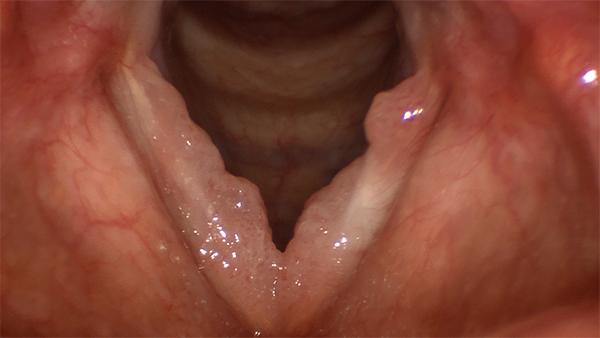What is papilloma?
A papilloma is a wartlike growth of the larynx, generally caused by the Human Papillomavirus (HPV). Different types of the HPV family of viruses cause similar growths elsewhere in the body. The papilloma virus is usually transmitted from person to person by intimate contact. However, not everyone who comes into contact with the virus will develop papilloma growths, and it may be that some people carry the virus unwittingly without developing growths, so understanding transmission has been complicated. The growth of the lesions of papilloma generally represents an interaction between the virus and the susceptibility in a given person’s immune system. Voice use has no bearing on the formation of papillomas.
Papilloma is best known as a disease of young children, most of whom appear to be infected by passage through the birth canal (genital warts are also caused by HPV). However, it can also affect adults. In adults, it is generally less aggressive than in children, meaning that papillomas grow slower and are less likely to grow outside of the larynx.
Similar to warts, papillomas are very resilient lesions, which tend to grow back no matter how completely they are removed. For that reason, the disease is also called recurrent respiratory papillomatosis, and is regarded as a chronic, incurable disease with an unpredictable course.
What are the symptoms of papilloma?
Papilloma generally causes painless hoarseness, worsening over time, roughly in proportion to the size and bulk of the lesions. If allowed to grow unchecked, it may block the airway and cause severe breathing difficulties.
What does papilloma look like?
Papilloma has a characteristic appearance of a stippled growth, not unlike a raspberry. These surface irregularities are called papillae and give the lesion its name.

The irregular stippled growths along the edges of both vocal folds in this image are papilloma.
Papilloma is a surface lesion, which grows outward from the mucosa. For reasons unknown, human papillomavirus seems to prefer the mucosa of the vocal fold, although lesions can and do grow on surrounding surfaces. In adults, papilloma may be confined to a single area of the vocal fold, and grow mimicking the appearance of a polyp, or it may extend over the entire surface of one or both folds.
In rare cases, usually when there is immune disease, papilloma may extend outside of the larynx to involve the mouth, the throat and the lungs. There have been reports of papilloma turning into cancer, but this is an extremely rare event.

Papilloma involves nearly the entire length of the vocal fold in the left of the image above. The other side is unaffected.
How is papilloma treated?
There is no reliable cure for papilloma. Surgery, which remains the mainstay of treatment, is used to keep the disease and the symptoms in check - but regrowth of papillomas is to be expected, no matter how thorough the excision. In some adult cases, particularly if the disease is limited to one site in the larynx, papilloma may disappear after one or more surgical removals. This is likely due to a person’s own immune system mounting an effective defense against recurrence.
Because surgery does not cure papillomatosis, functional considerations like voice quality remain relevant in the operating room. There is often little to be gained from an aggressive resection that irreversibly compromises voice. Most patients face multiple procedures, and leaving a small amount of the disease in place, in order to minimize scar, is often a sound practice. This is particularly true around the front of the vocal folds, where surgery on both sides may yield a bridging scar, or web.
![]](https://voice.weill.cornell.edu/sites/default/files/styles/panopoly_image_original/public/pap_fig_3.jpg?itok=-5uOIbbV)
Bulky papilloma nearly fills in the space between the vocal folds. If ignored, papilloma can grow large enough to affect breathing.
If the disease recurs, the decision for repeat surgery is determined by disease bulk and impairment to voice. In people with widespread disease across the larynx, there is generally little reason to re-operate for each small area of recurrence, if symptoms are not present. This may be difficult for an affected person to accept, but operating more often does not affect the overall course of the disease, and may unnecessarily expose a person to the risks of surgery and cumulative damage from scar. Because the mucosa of the vocal fold must be removed in the area of papilloma, healing often results in impaired vocal fold vibration (see Normal Voice Function). It is rare that extensive cases of the disease can be operated upon multiple times without causing some permanent change in voice.
In cases which genuinely require frequent surgery - and it may be called for as often as every two or three months in exceptional cases - it is reasonable to consider investigational therapy. Because of the frustrating nature of the disease, there are a wide variety of alternative and investigational treatments. Currently, medical focus rests upon cidofovir - a drug used intravenously against other viruses. Ideal dosing and frequency of administration are currently being investigated. Researchers are also investigating ways to modify the immune system so that it can better fight the disease.
The Recurrent Respiratory Papillomatosis Information, Support and Advocacy Center is a wealth of information regarding papilloma, kept current and complete by its webmaster and the interaction of its members.

